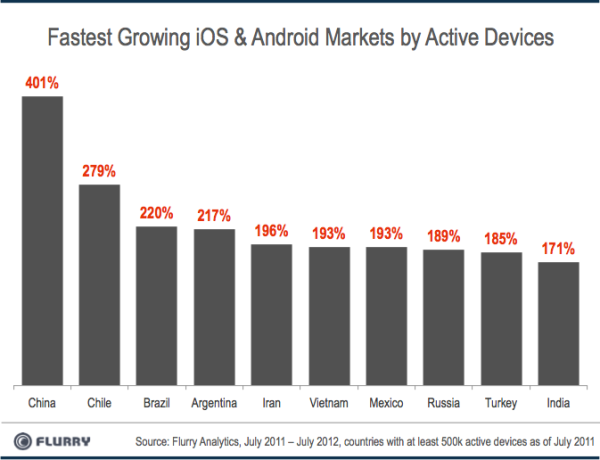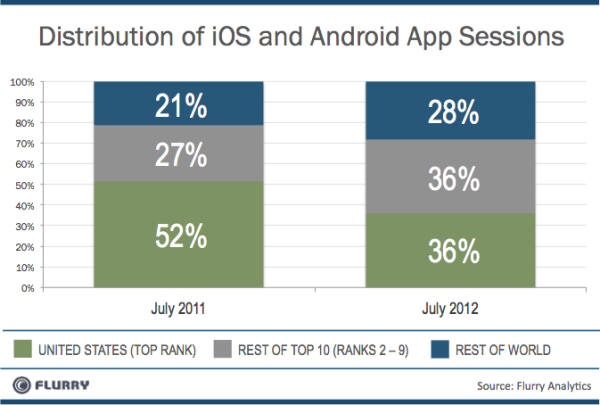China is the fastest growing market for iOS and Android devices, Chile ranks second
The speed of distribution of devices on iOS and Android in the world amazes everyone - this is the fastest "accepted" consumer technology in the history of mankind. Smartphones are ahead of the spread of personal computers in the 80s 10 times, 2 times the spread of the Internet in the 90s and 3 times the adoption of social networks in the 2000s. Flurry analysts take great pleasure in tracking the trends in the spread of applications and mobile devices in our lives, and yesterday they published some new data regarding the adoption of iOS and Android in the world.
The United States continues to lead in the number of active iOS and Andriod devices with its 165 million units, followed immediately by China with 128 million active network devices. Then there is a big gap in numbers - the UK is third with 31 million active devices, while South Korea and Japan close the top five with 28 and 22 million devices, respectively.

')
It may not surprise anyone that China is right behind the United States — the population is partly affected by such high rates — but, surprisingly, this is a large number of different impulses driving the development of the Chinese smartphone market.
China has become the largest smartphone market in terms of the number of devices sold last year, and now Flurri marks China (what a surprise!) As the fastest growing market for iOS and Andriod devices. China's smart device market grew by just over 400% compared to last year, easily beating its BRIC-Russia and Brazil partners, whose smartphone markets grew (quite impressively) by 189% and 220%, respectively, from July 2011 to July 2012.

Interestingly, the second prize went to Chile, which showed 279% annual growth. This South American country has quite established itself as a center for the development of startups (largely thanks to innovative programs supported by the government, such as Startup Chile ), and it promises to be an excellent place for the development of the mobile industry.
One thing that, unfortunately, Flurry did not analyze, is how the market for the iOS and Andriod platforms in these countries is divided. Earlier this month, the Wall Street Journal wrote that the share of iOS in the Chinese market has dropped quite significantly, because potential consumers are waiting for the announced release of the new iPhone model. Meanwhile, experienced Chinese technical designers are increasingly reducing the quality gap between their devices and the phones of world leaders - just look at the devices from Huawei, Meizu and Xiaomi. The numbers for Chile are a bit more difficult to find, but as expected, sales of smartphones and tablets should increase significantly this year - according to Marco Soto from IDC Latin America, most of the tablets sold in Chile in 2011 work on Andriod. Moreover, Google may focus on this region, according to Google’s words from Hugo Barr, a group of journalists in Santiago, he said that 2012 will be the year of smartphones in Latin America.

Finally, the analytic company analyzed the use of applications in the world. As can be seen from the graph, the American sessions in iOS and Android applications for the year are expected to be reduced from half to one third. It can be assumed that this graph with the further penetration of smartphones in the world will continue to expand in favor of the “rest of the world”.
The United States continues to lead in the number of active iOS and Andriod devices with its 165 million units, followed immediately by China with 128 million active network devices. Then there is a big gap in numbers - the UK is third with 31 million active devices, while South Korea and Japan close the top five with 28 and 22 million devices, respectively.

')
It may not surprise anyone that China is right behind the United States — the population is partly affected by such high rates — but, surprisingly, this is a large number of different impulses driving the development of the Chinese smartphone market.
China has become the largest smartphone market in terms of the number of devices sold last year, and now Flurri marks China (what a surprise!) As the fastest growing market for iOS and Andriod devices. China's smart device market grew by just over 400% compared to last year, easily beating its BRIC-Russia and Brazil partners, whose smartphone markets grew (quite impressively) by 189% and 220%, respectively, from July 2011 to July 2012.

Interestingly, the second prize went to Chile, which showed 279% annual growth. This South American country has quite established itself as a center for the development of startups (largely thanks to innovative programs supported by the government, such as Startup Chile ), and it promises to be an excellent place for the development of the mobile industry.
One thing that, unfortunately, Flurry did not analyze, is how the market for the iOS and Andriod platforms in these countries is divided. Earlier this month, the Wall Street Journal wrote that the share of iOS in the Chinese market has dropped quite significantly, because potential consumers are waiting for the announced release of the new iPhone model. Meanwhile, experienced Chinese technical designers are increasingly reducing the quality gap between their devices and the phones of world leaders - just look at the devices from Huawei, Meizu and Xiaomi. The numbers for Chile are a bit more difficult to find, but as expected, sales of smartphones and tablets should increase significantly this year - according to Marco Soto from IDC Latin America, most of the tablets sold in Chile in 2011 work on Andriod. Moreover, Google may focus on this region, according to Google’s words from Hugo Barr, a group of journalists in Santiago, he said that 2012 will be the year of smartphones in Latin America.

Finally, the analytic company analyzed the use of applications in the world. As can be seen from the graph, the American sessions in iOS and Android applications for the year are expected to be reduced from half to one third. It can be assumed that this graph with the further penetration of smartphones in the world will continue to expand in favor of the “rest of the world”.
Source: https://habr.com/ru/post/150353/
All Articles